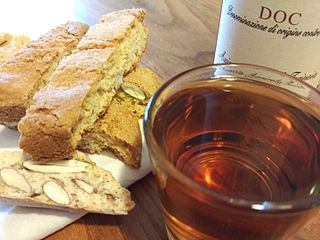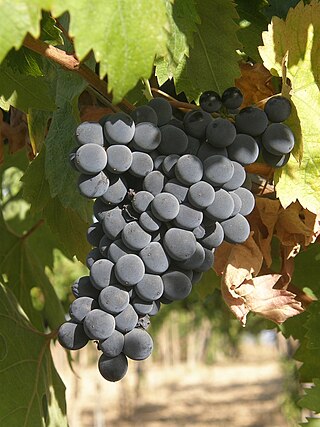
Chianti is an Italian red wine produced in the Chianti region of central Tuscany, principally from the Sangiovese grape. It was historically associated with a squat bottle enclosed in a straw basket, called a fiasco. However, the fiasco is now only used by a few makers of the wine; most Chianti is bottled in more standard-shaped wine bottles. In the latter nineteenth century, Baron Bettino Ricasoli helped establish Sangiovese as the blend's dominant grape variety, creating the blueprint for today's Chianti wines.

Cabernet Sauvignon is one of the world's most widely recognized red wine grape varieties. It is grown in nearly every major wine producing country among a diverse spectrum of climates from Australia and British Columbia, Canada to Lebanon's Beqaa Valley. Cabernet Sauvignon became internationally recognized through its prominence in Bordeaux wines, where it is often blended with Merlot and Cabernet Franc. From France and Spain, the grape spread across Europe and to the New World where it found new homes in places like California's Napa Valley, New Zealand's Hawke's Bay, South Africa's Stellenbosch region, Australia's Margaret River, McLaren Vale and Coonawarra regions, and Chile's Maipo Valley and Colchagua. For most of the 20th century, it was the world's most widely planted premium red wine grape until it was surpassed by Merlot in the 1990s. However, by 2015, Cabernet Sauvignon had once again become the most widely planted wine grape, with a total of 341,000 hectares (3,410 km2) under vine worldwide.

Sangiovese is a red Italian wine grape variety that derives its name from the Latin sanguis Jovis, "the blood of Jupiter".

Verdicchio is a white Italian wine grape variety grown primarily in the Marche region of central Italy. The name Verdicchio derives from verde and refers to the slight green/yellow hue that wines made from the grape can have.

Italian wine is produced in every region of Italy. Italy is the world's largest wine producer, as well as the country with the widest variety of indigenous grapevine in the world, with an area of 702,000 hectares under vineyard cultivation, and contributing a 2013–2017 annual average of 48.3 million hl of wine. In 2018 Italy accounted for 19 per cent of global production, ahead of France and Spain. Italian wine is both exported around the world and popular domestically among Italians, who consume an average of 42 litres per capita, ranking fifth in world wine consumption.

Vin Santo is a style of Italian dessert wine. Traditional in Tuscany, these wines are often made from white grape varieties such as Trebbiano and Malvasia, though Sangiovese may be used to produce a rosé style known as "Occhio di Pernice" or eye of the partridge. The wines may also be described as straw wines since they are often produced by drying the freshly harvested grapes on straw mats in a warm and well ventilated area of the house. Though technically a dessert wine, a Vin Santo can vary in sweetness levels from bone dry to extremely sweet. While the style is believed to have originated in Tuscany, examples of Vin Santo can be found throughout Italy and it is an authorised style of wine for several denominazione di origine controllata (DOCs) and indicazione geografica tipica (IGTs).

Torgiano is a comune (municipality) in the Province of Perugia in the Italian region Umbria, located about 10 km southeast of Perugia.

Marchesi Antinori Srl is an Italian wine company, based in Florence, Tuscany, that can trace its history back to 1385. They are one of the biggest wine companies in Italy, and their innovations played a large part in the "Super-Tuscan" revolution of the 1970s.

Montepulciano is a red Italian wine grape variety that is most noted for being the primary grape behind the DOCG wines Colline Teramane Montepulciano d'Abruzzo and Offida Rosso; and the DOC wines Montepulciano d'Abruzzo, Rosso Conero, and Rosso Piceno Superiore.

Tuscan wine is Italian wine from the Tuscany region. Located in central Italy along the Tyrrhenian coast, Tuscany is home to some of the world's most notable wine regions. Chianti, Brunello di Montalcino and Vino Nobile di Montepulciano are primarily made with Sangiovese grape whereas the Vernaccia grape is the basis of the white Vernaccia di San Gimignano. Tuscany is also known for the dessert wine Vin Santo, made from a variety of the region's grapes. Tuscany has forty-one Denominazioni di origine controllata (DOC) and eleven Denominazioni di Origine Controllata e Garantita (DOCG). In the 1970s a new class of wines known in the trade as "Super Tuscans" emerged. These wines were made outside DOC/DOCG regulations but were considered of high quality and commanded high prices. Many of these wines became cult wines. In the reformation of the Italian classification system many of the original Super Tuscans now qualify as DOC or DOCG wines but some producers still prefer the declassified rankings or to use the Indicazione Geografica Tipica (IGT) classification of Toscana. Tuscany has six sub-categories of IGT wines today.

Friuli-Venezia Giulia wine is wine made in the northeastern Italian region of Friuli-Venezia Giulia. There are 11 denominazione di origine controllata (DOC) and 3 denominazione di origine controllata e garantita (DOCG) in the Friuli-Venezia Giulia area. The region has 3 indicazione geografica tipica (IGT) designations Alto Livenza, delle Venezie and Venezia Giulia. Nearly 62% of the wine produced in the region falls under a DOC designation. The area is known predominantly for its white wines, which are considered some of the best examples of Italian wine in that style. Along with the Veneto and Trentino-Alto Adige, the Friuli-Venezia Giulia forms the Tre Venezie wine region, which ranks with Tuscany and Piedmont as Italy's world class wine regions.

Orvieto is an Italian wine region located in Umbria and Lazio, centered on the comune of Orvieto. It is primarily known for its white wines made from a blend of mostly Grechetto and Trebbiano, which is sold under the Denominazione di origine controllata (DOC) Orvieto and Orvieto Classico. Blended red wine and eight varietal reds are sold under the Rosso Orvietano DOC. The region has been producing wine since the Middle Ages, when Orvieto wine was known as a sweet, golden-yellow wine. Today's white Orvieto is dry, but a semi-sweet style, known as Orvieto Abboccato, and dolce (sweet), are also produced in small quantities.
Montecarlo is a denominazione di origine controllata (DOC) in northern Tuscany, Italy. The vineyards surround the small town of Montecarlo which is located close to Lucca and Pisa. Montecarlo wines are unusual for the region in that they are commonly made from the Sémillon, Sauvignon blanc and Pinot bianco grape varietals. This is unusual as most Tuscan white wines are made from Trebbiano and Malvasia grapes. Wines from the region are often called the best Tuscan whites.
Abrusco is a red Italian wine grape variety grown primarily in the Tuscany region where it is a minor blending component permitted in the wines of Chianti. The grape has long history in the region and was mentioned in 1600, under its synonyms Abrostino and Colore, in the posthumously published work by Italian agronomist Giovan Vettorio Soderini Trattato della coltivazione delle viti, e del frutto che se ne può cavare. There Soderini notes that the grape was often used to add deeper, more red color to Tuscan wines.

Bolgheri is a central Italian village and hamlet (frazione) of Castagneto Carducci, a municipality (comune) in the province of Livorno, Tuscany. in 2011 it had a population of 131.
Sovana is a denominazione di origine controllata red or rosé wine from the south of Tuscany, in Italy. The DOC is named after the ancient Etruscan settlement of Sovana. Sovana received DOC status in 1999, along with its neighbor, the DOC Capalbio. Sovana encompasses roughly the same areas that produce the white wine Bianco di Pitigliano, and encompasses the towns of Pitigliano, Sorano, Manciano and borders the DOC Morellino di Scansano in the north, and the region of Lazio in the south.
Negrara is a red Italian wine grape variety grown in north east Italy including the Veneto region where it is a permitted variety in the Denominazione di origine controllata (DOC) wine Amarone. While the grape was once more widely planted in the region its numbers have been steadily declining for most of the late 20th and early 21st century.

Abruzzo is an Italian wine region located in the mountainous central Italian region of Abruzzo, along the Adriatic Sea. It is bordered by the Molise wine region to the south, Marche to the north and Lazio to the west. Abruzzo's rugged terrain, 65% of which is mountainous, help to isolate the region from the winemaking influence of the ancient Romans and Etruscans in Tuscany, but the area has had a long history of wine production.
Abbuoto is a red Italian wine grape variety that is grown primarily in the Lazio region of central Italy. Historically the grape was believed to be responsible for the Ancient Roman wine Caecubum that was praised by writers such as Pliny the Elder and Horace but historians and wine experts such as Jancis Robinson and Julia Harding note that connection is likely erroneous.

Montefalco wine is a style of Italian wine made in Umbria, and awarded Denominazione di origine controllata (DOC) status in 1979.













